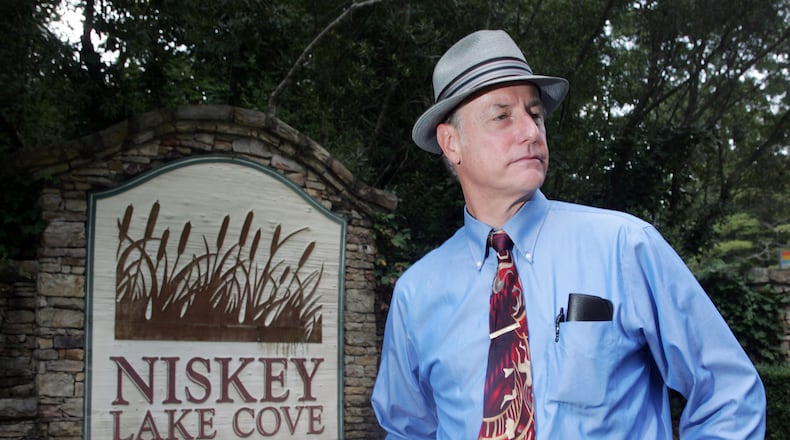The cloistered, new subdivisions and towering McMansions made it difficult for retired homicide detective Danny Agan to get his bearings. He remembered a more rural setting -- the kind of place where a killer would feel comfortable dumping his prey.
“It was right about here,” said Agan, pointing to an embankment off Niskey Lake Road in southwest Atlanta. Thirty summers ago, the rookie detective discovered the first of 29 missing and murdered African-American youths taken from Atlanta’s streets between 1979-81.
“The body was badly decomposed by the summer heat,” said Agan, who had responded to a 911 call from an aluminum can collector who found the bones not far from the road.
“You couldn’t tell whether it was human,” Again said. As he searched for clues, the investigator came across more skeletal remains roughly 75 yards away. A young person’s clothes draped the bones, which were better preserved but only vaguely human.
“These bodies were just dumped there,” Agan recalled this week. “There was no evidence at first they were related.”
Their deaths drew scant attention outside of their southwest Atlanta neighborhood. The Atlanta Constitution ran a brief on page 19-A about the discovery of two bodies. Their names -- Edward Hope Smith and Alfred Evans -- and ages -- both 14 -- were not yet known.
Another crime had grabbed the headlines, much like the murder of former boxing champion Vernon Forrest has today. On June 28, 1979, a young doctor attending a downtown convention was shot and killed by two thieves, bringing an unwanted spotlight on the city too busy to hate.
His was one of 113 homicides recorded in Atlanta over the first six months of 1979 -- eight more than occurred in all of 2008. Atlanta went on to record 269 homicides that year, worst among all U.S. cities.
By early August, just two weeks after the discovery of the two youth’s bodies, then-Gov. George Busbee enlisted Georgia State Patrol officers to help an overwhelmed Atlanta Police Department. Lawsuits claiming the department had biased hiring and promotional policies -- suits filed by both black and white police groups -- had resulted in a court-ordered hiring freeze at the APD.
Meanwhile, the investigations into the deaths of Smith and Evans hit a wall. The case joined a backlog of other slayings.
“We had 25 murders in one month,” Agan recalled. “It was business as usual. You gotta remember, we were the murder capital of the country back then.”
In the homicide department, detectives “just tried to keep their heads above water,” he said.
Smith would be identified through dental records. He had been reported missing July 28 -- the day his body was found -- though other accounts say Edward was last seen a week earlier walking home from a skating rink. Cause of death: a gunshot to the head.
Alfred was reportedly last seen waiting for a bus in East Lake Meadows, a notorious housing project in East Atlanta. Other accounts had him leaving a movie with a friend.
His body was never positively ID’d, though most believe he was the first victim. The medical examiner speculated Alfred died from asphyxia, possibly resulting from strangulation. It would become the killer’s calling card.
Tayari Jones was in the gifted program at Oglethorpe Elementary with 9-year-old Yusef Bell -- “a real smart young man,” she remembers. He went missing in late October, a little more than a month after 14-year-old Milton Harvey disappeared.
Both bodies were discovered in November. Harvey’s was so badly decomposed a cause of death couldn’t be determined. Yusef, found stuffed into a crawl space beneath a classroom in an abandoned school, had been strangled.
“I really remember this as the most significant event of my childhood,” said Jones, who wrote a memoir, “Leaving Atlanta,” about coming of age during the child murders. “It became a part of our lives.”
With four children dead in a span of four months, the whispers grew. Was a serial killer, targeting children, loose on the streets of Atlanta?
The following March left no debate. Within a span of two weeks, three more youths disappeared. They shared much in common.
“All black males, under 14, most of them street kids, died of asphyxiation,” recalled retired APD Det. Bob Buffington, who worked on one of the cases.
City leaders, he said, were in denial.
“There was considerable political concern,” he said. “People didn’t want this to get out. There had already been a lot of stories about crime in Atlanta. This is the last thing they needed.”
“It was a very difficult time to conduct these investigations because of the politics,” he said. “Every move we made, they put an obstacle in front of us.”
While investigating, along with Agan, the murder of Eric Middlebrooks, 14, he made a discovery that would end up becoming a key part of the prosecution’s case.
“Middlebrooks had on high top tennis shoes,” he said. “The little strip of rubber, with the Converse label on it, had come loose as the body had been dragged across some carpet. The fibers had collected between this loose rubber strip.”
Buffington found more carpet fibers in Middlebrooks’ hair. His colleagues were not impressed.
“We got a bunch of razzing,” he said. “‘You can’t use that.’ But we figured, ‘Why not?’
On the streets, the rumors circulated with abandon.
“If you don’t know who it is, you don’t know who it’s not,” said Jones, now a professor of creative writing at Rutgers-Newark University.
The Ku Klux Klan was suspected. Others thought the police were involved.
A group that called itself the “Bat Patrol” provided security at the now-defunct Techwood Homes housing project near Georgia Tech (joined, at various junctures, by the Guardian Angels and Nation of Islam). Fearing riots, police arrested four members of the group on their first night patrol. After the arrests, scores of Techwood residents drove to the police station to protest.
“The cops and the Klan work hand-in-hand,” they chanted.
By the spring of 1981, with the number of victims at 21, Atlanta police’s Missing and Murdered task force had grown from five to 40. The FBI had 24 agents working the case.
On April 22, 1981, a police recruit staking out the Chattahoochee River heard a splash. Then he noticed a station wagon passing overheard on the South Cobb Drive bridge. The recruit stopped and questioned the driver, Wayne Williams, a 23-year-old freelance photographer. Two days later, the body of Nathaniel Cater surfaced downstream, near where the body of Jimmy Ray Payne was found a month earlier.
Williams was arrested June 21, 1981. On Feb. 27, 1982, he was found guilty of killing Cater and Payne and, thanks to the fiber evidence found by Buffington, all but six of the murders were linked to Williams.
Buffington figures that’s too many, though he doesn’t doubt Williams’ guilt.
“Wayne was a necrophile and a pedophile,” he said. “The evidence is overwhelming.”
Recent DNA tests failed to exonerate Williams, who maintains his innocence.
He’s serving a life sentence -- as is one of the detectives who investigated his case: Sidney Dorsey, the former DeKalb County Sheriff who ordered the assassination of his successor, Derwin Brown.
Jones, like many in the African-American community, has her doubts about Williams’ guilt.
“The word on the streets in SW Atlanta at the time was, ‘He didn’t do it, he didn’t do it,’” Jones remembered. “I think about [Williams] sometimes. Did he or didn’t he? I don’t know.”
She’s more certain about the lessons learned, ones that reverberate today.
“I learned, as a kid, some people are more vulnerable than others. It wasn’t ambiguous,” the author said. “These kids’ parents weren’t in the NAACP. They didn’t go to Morehouse or Spelman. They were part of a disposable class of people. That part of the story has been forgotten, as it so often is.”
About the Author
The Latest
Featured



